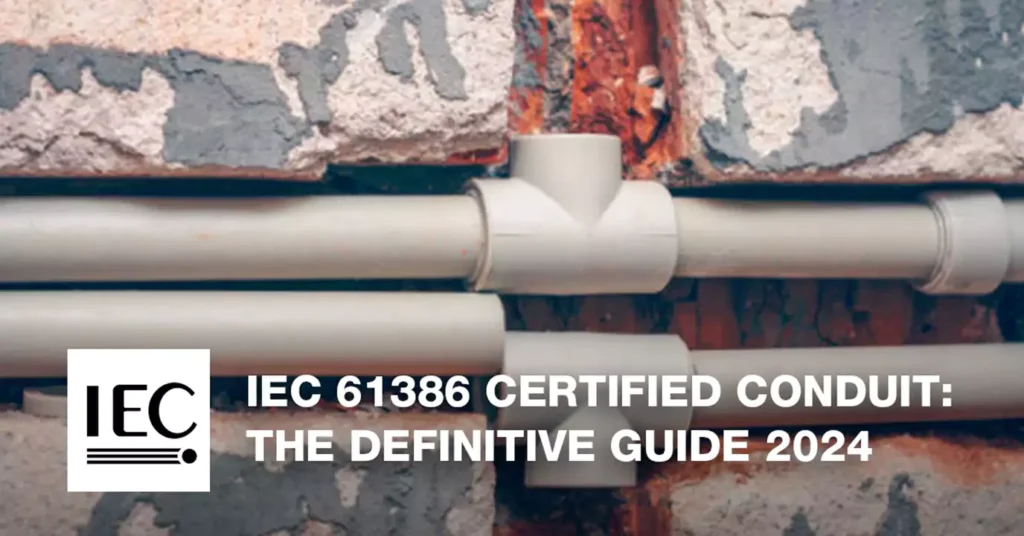
Tabla de contenido
As industries continue to evolve, the demand for efficient, safe, and reliable electrical conduit systems has intensified. The complexity of modern electrical installations necessitates advanced solutions for protecting and routing wires. Consequently, the standards governing wire pipes, such as electrical conduits, have become increasingly stringent to address the diverse needs of various applications and regions.
Different countries and regions enforce unique requirements for electrical installations. These regional variances underscore the importance of adopting a global standard to harmonize practices and ensure uniform safety and performance benchmarks. One such pivotal standard is the IEC 61386.
By exploring this definitive guide, you will gain valuable insights into:
- The scope of application of IEC 61386.
- The testing procedures required for IEC 61386-certified conduits .
- Quality control of conduit production.
- Related standards for IEC 61386-certified conduits and LSZH conduits.
- Applications of IEC 61386-certified conduits.
- The Importance of Compliance with IEC 61386 and related standards
Statement
All content in this guide is based on the IEC 61386:2008 version, and the ownership of this standard belongs to the International Electrotechnical Commission (IEC).
Definición
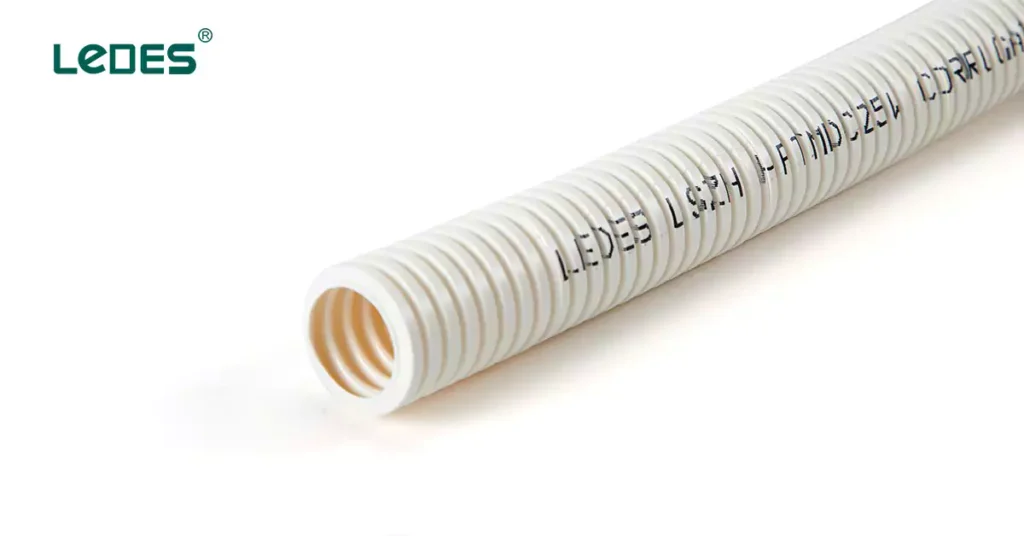
At its core, the IEC 61386 standard represents a critical framework for ensuring the safety, reliability, and performance of electrical conduit systems. While the materials and designs of conduits can vary, such as conducto de PVC rígido, LSZH conduit, or halogen-free conduit, the principles set forth by the IEC serve as a universal benchmark for quality.
Understanding IEC Standard
The International Electrotechnical Commission (IEC) is a global organization responsible for developing and maintaining standards for electrical and electronic technologies. These standards ensure compatibility, safety, and efficiency across international markets, playing a crucial role in industrial progress and innovation.
The Role of IEC 61386 Standard
IEC 61386 specifies the requirements for conduit systems used to protect and route electrical wiring in diverse environments. It includes guidelines for:
- Mechanical properties: Assessing the strength and durability of conduits, including rigid PVC conduit and similar types.
- Thermal and environmental resistance: Ensuring performance in extreme conditions.
- Fire safety: Including standards for LSZH (Low Smoke Zero Halogen) conduit to reduce toxic emissions in the event of a fire.
Scope of IEC 61386 Standard
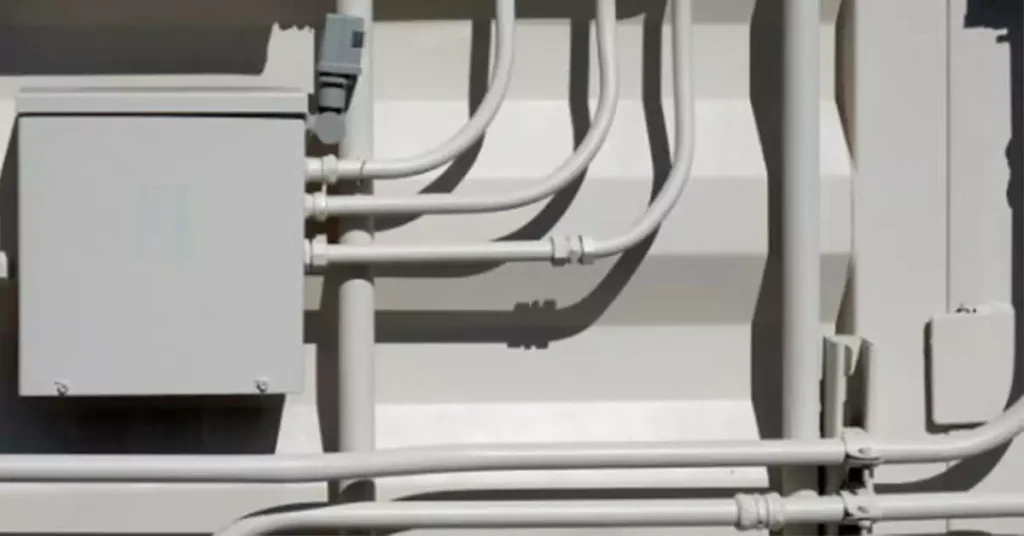
The IEC 61386 standard defines comprehensive requirements and testing methodologies for conduit systems, encompassing both conduits and conduit fittings. These systems are essential for the protection and management of insulated conductors and cables in electrical installations or communication systems.
Key Applications
The standard is applicable to electrical systems operating at:
- Hasta 1,000 V a.c. (alternating current).
- Hasta 1,500 V d.c. (direct current).
It ensures that conduit systems can reliably support and safeguard electrical and communication infrastructure under diverse conditions.
Material Categories
IEC 61386 covers a broad range of conduit systems based on material composition:
- Metallic conduit systems: Known for their strength and durability in industrial settings.
- Non-metallic conduit systems: Such as PVC conduit and halogen-free conduit, which offer lightweight and corrosion-resistant options.
- Composite conduit systems: Combining metallic and non-metallic properties for specialized applications.
IEC 61386 Standard Index Content
The IEC 61386 standard serves as a comprehensive guide for the design, construction, and testing of conduit systems used in electrical installations. It outlines essential parameters to ensure these systems meet stringent performance and safety criteria. Below are some core aspects of the standard based on its table of contents.
- Conduit Classification
- Marking
- Dimensiones
- Propiedades mecánicas
- Electrical Properties
- Thermal Properties
- Fire Hazard
- External Influences
- Electromagnetic Compatibility (EMC)
IEC 61386 Standard: Definitive Explains
The IEC 61386 standard is divided into multiple parts, with IEC 61386-1 serving as the general requirements and IEC 61386-21 specifying additional requirements for rigid conduit systems, IEC 61386-23 specifying additional requirements for flexible conduit systems. Together, these standards provide a structured and comprehensive framework for conduit systems used in electrical installations. Below is a detailed breakdown of the chapters of IEC 61386-1 combining with IEC 61386-21, explaining key requirements, tests, and applications.
General Requirements
The standards set the baseline for conduit system performance, emphasizing reliability, durability, and safety. The general requirements ensure that conduit systems:
- Protect conductors and cables effectively.
- Withstand everyday stresses during handling, installation, and operation.
- Maintain the declared performance across the entire system, including joints.
General Conditions for Tests
To ensure the accuracy across testing facilities, here are the key points of testing conditions:
- Testing Environment: Standard ambient temperature of (20 ± 5)°C for consistency.
- Sample Conditioning: Non-metallic/composite samples must be conditioned for 240 hours at (23 ± 2)°C with 40%-60% humidity.
- Preparation & Assembly: Samples must be clean, new, and assembled per manufacturer instructions.
- Reassembly of Fittings: Detachable fittings must reassemble post-test without losing properties.
Electrical Conduit Classification
Electrical conduit systems are classified according to performance under various conditions, such as mechanical strength, fire resistance, and ingress protection (IP).
The following categories outline the levels of mechanical performance:
Consejos: If you would like to learn more about the difference between medium-duty and heavy-duty electrical conduits, you can read our last post.
Electrical Conduit Classification According to Mechanical Strength
Clasificación | Load Requirement (N) | Aplicaciones |
Muy claro | Up to 125N | Light-duty installations, minimal mechanical stress |
Luz | 125 N to 320 N | Indoor use, low-stress environments. |
Medio | 320 N to 750 N | General-purpose use, moderate mechanical stress. |
Pesado | 750 N to 1250 N | Outdoor or industrial settings with high mechanical stress. |
Muy pesado | Over 1250 N | Extreme conditions, heavy-duty industrial or underground installations. |
- The classification corresponds to the conduit’s resistance to compression under specified test conditions.
- Proper selection ensures the conduit meets the environmental and operational demands of its intended application.
Electrical Conduit Classification According to Temperature
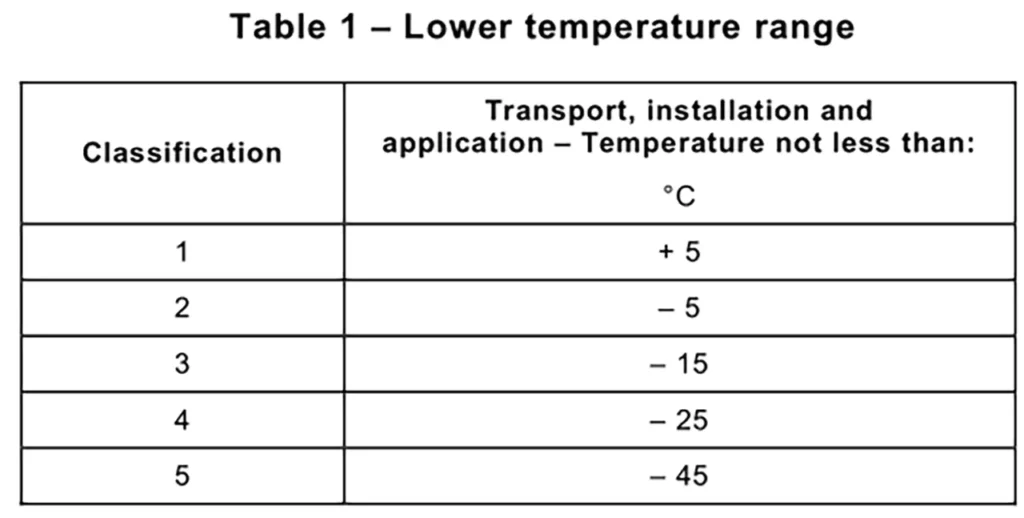
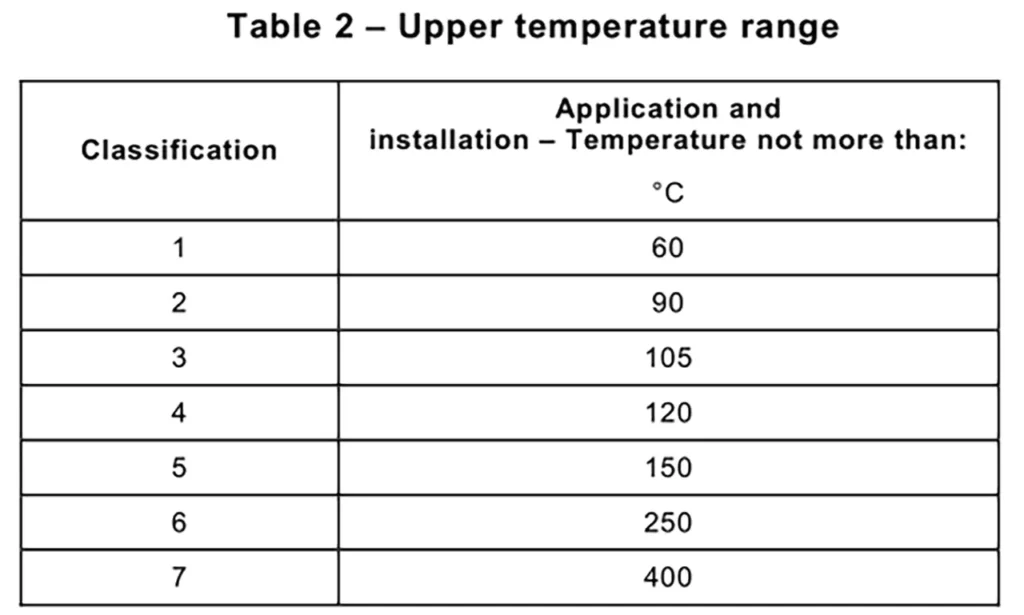
Electrical Conduit Marking
Key Requirements:
Durable Marking: Product markings must withstand environmental and mechanical stresses.
Content: Markings must include the conduit sizes, manufacturer’s name, product classification, and standard compliance.
Traceability: Documentation must accompany products, detailing material properties and test results.
Electrical Conduit Dimensions
IEC 61386 together with IEC 60423 ensure conduits and fittings meet specific dimensional requirements to guarantee compatibility and performance.
Here are the dimensions requirements for Non-threaded conduit:
Dimensions of Non-threaded Electrical Conduit
Tamaño mm | sobredosis mm | Max. entry diameter mm | Min. entry length mm |
6 | 6 | 06.5 | 06.0 |
8 | 8 | 08.5 | 08.0 |
10 | 10 | 10.5 | 10.0 |
12 | 12 | 12.5 | 12.0 |
16 | 16 | 16.5 | 16.0 |
20 | 20 | 20.5 | 20.0 |
25 | 25 | 25.5 | 25.0 |
32 | 32 | 32.6 | 30.0 |
40 | 40 | 40.7 | 32.0 |
50 | 50 | 50.8 | 42.0 |
63 | 63 | 63.9 | 50.0 |
75 | 75 | 75.9 | 50.0 |
Minimum Inside Diameter: There are no specific requirements of minimum inside diameter and wall thickness in the IEC, but states that the minimum inside diameter of the conduit system shall be as declared by the fabricante de conductos electricos.
Propiedades mecánicas
Conduit systems should have adequate mechanical strength according to their different classification. And after subjected to these mechanical tests, the conduit should not crack or deformed to ab extent that effect the wiring installations.
Compression Test
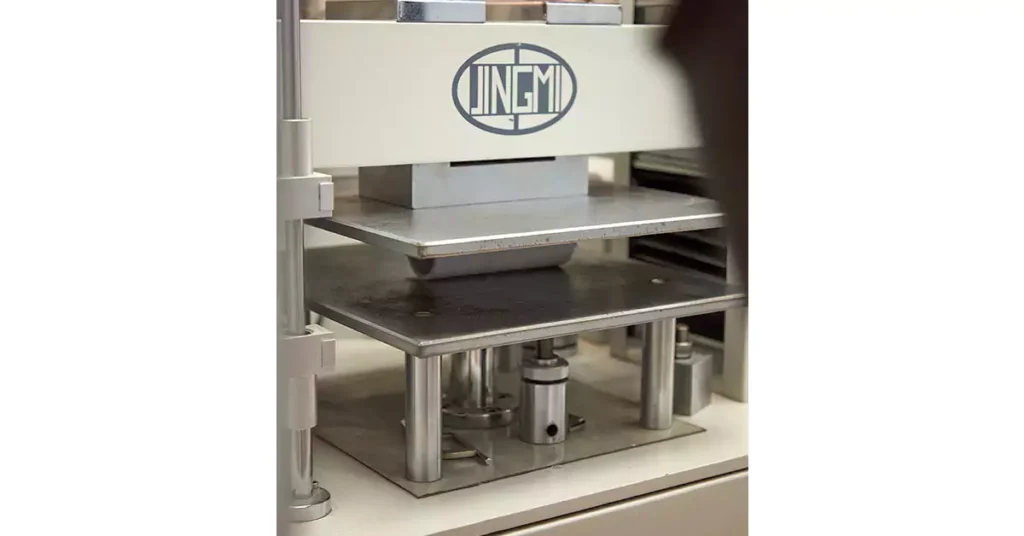
Objetivo: Ensures the conduit can resist crushing forces.
Procedure: A specified load is applied over a fixed duration of 60 s.
Criteria: No permanent deformation or cracking is allowed and diameter difference should not exceed a certain percentage.
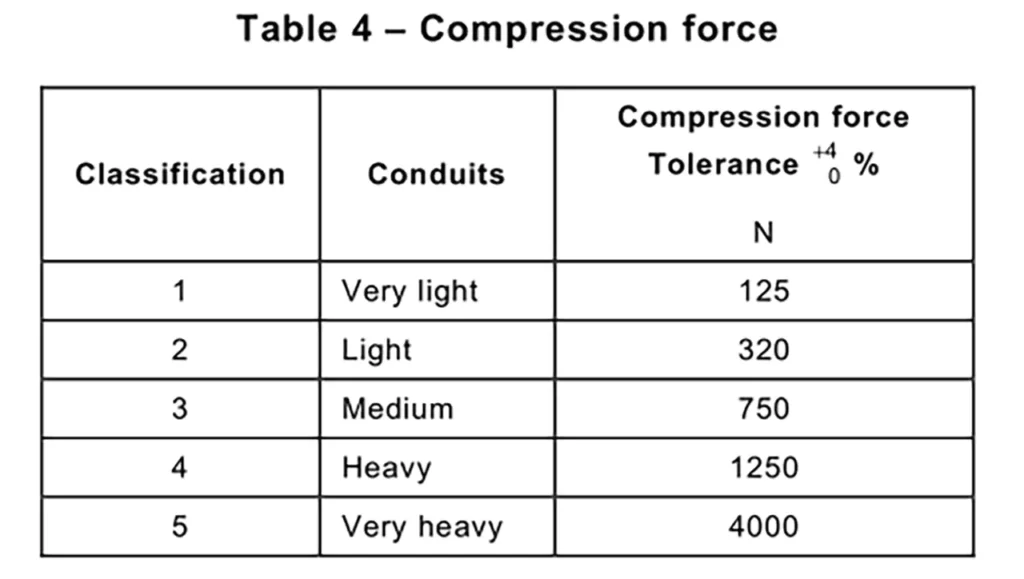
Resistencia al impacto
Objetivo: Assesses the conduit’s ability to withstand sudden mechanical impacts.
Procedure: Conditioning the samples at the declared temperature for 2 hours, dropping a weighted hammer onto the sample.
Criteria: No visible cracks or structural failure.
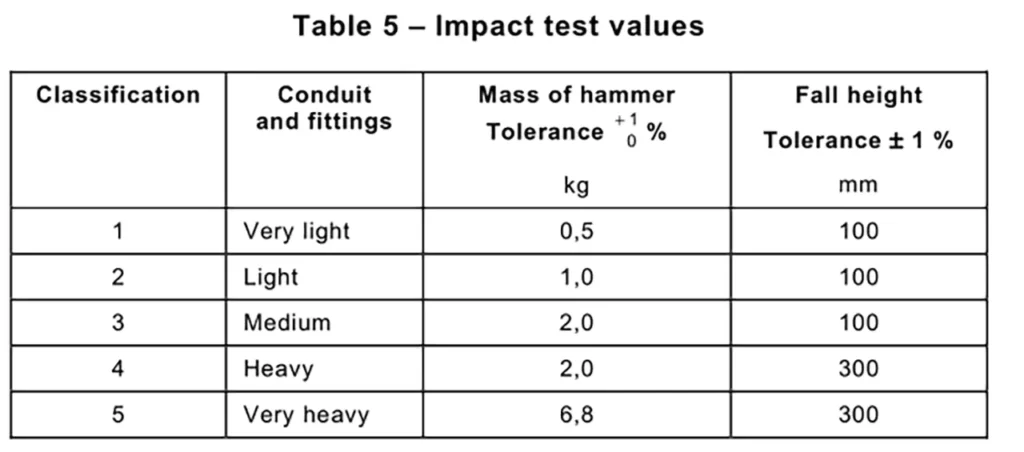
Bending Test
Objetivo: Determines flexibility and resilience.
Flexible conduits in IEC 61386-23 are not applicable for this test.
And according to IEC 61386-21, following are the key points of the non-metallic conduit’s bending test.
Acondicionamiento: Sample is refrigerated for 2 hours at the declared temperature (±2 °C).
Procedure: Bend the sample to 90° ± 5° within 12 ± 2 seconds after removal from the refrigerator.
Pass Criteria: No visible cracks, and a gauge must pass through the sample under its own weight.
Flexing Test
Objetivo: To evaluate the durability and performance of a conduit and its fittings under repeated flexing motions. It ensures that the conduit can withstand mechanical stresses during operation without cracking or losing its internal clearance, maintaining its structural integrity and functional reliability in real-world applications.
Rigid conduits in the IEC 61386-21 are not applicable for this test.
Muestras: Six conduits tested: three at the minimum declared temperature (Table 1) and three at the maximum declared temperature (Table 2), both ±2 °C. Flexible conduits for ambient-only flexing are tested at 20 °C ± 2 °C.
Acondicionamiento: Samples conditioned for at least 2 hours or until reaching the declared temperature.
Procedimiento de prueba: Oscillate the conduit 180° ± 5° (sinusoidal motion).
Perform 5,000 flexings at a rate of 40 ± 5 flexings per minute.
Pass Criteria: No visible cracks; appropriate gauge must pass through the sample under its own weight.
Collapse
Objetivo: To assess the ability of bendable conduits to maintain their internal passage and structural integrity when subjected to prolonged exposure to heat and mechanical stress.
Applicability: Only non-metallic and composite conduits apply to this test, metallic conduit is not applicable. And conduits from part 23 of IEC are not applicable
Test Setup:
Samples are fixed to a rigid support with four straps.
The assembly is placed in a heating cabinet at the declared temperature (Table 2) ±2 °C for 24 hours ± 15 minutes.
Procedimiento de prueba: Position the sample so its straight portions are at a 45° angle to vertical, with one end pointing upward.
Pass Criteria: The appropriate gauge must pass through the conduit under its own weight without any initial speed.
Resistencia a la tracción
Objetivo: To verify the mechanical integrity and tensile strength of conduit systems, ensuring that they can withstand pulling forces without separation or damage during installation and operation.
Test Conditions:
Apply a uniformly increasing tensile force as bellow table at 23 ± 2 °C over 30 ± 3 seconds.
Maintain the force for 2 minutes ± 10 seconds.
Elongation: If elongation occurs, the manufacturer must provide installation guidelines.
Pass Criteria: Fittings must remain properly assembled.
No visible damage to the conduit or fittings.
Flexible conduits in IEC 61386-23 are not applicable for this test.
IEC 61386 Tensile Force Date Table
Clasificación | Conduit and fittings | Tensile force Tolerance +2% |
1 | Muy claro | 100 |
2 | Luz | 250 |
3 | Medio | 500 |
4 | Pesado | 1000 |
5 | Muy pesado | 2500 |
Electrical Properties
IEC 61386 outlines the electrical performance requirements for conduit systems, ensuring safety and reliability in electrical installations. It covers key aspects like electrical requirements, bonding, dielectric strength, and insulation resistance.
Electrical Requirements
Conduit systems must provide reliable electrical protection for conductors and cables housed within.
- They must prevent short circuits, electrical leakage, or other hazards caused by environmental factors like moisture, dust, or physical stress.
- Electrical conduits are expected to maintain performance under varying conditions, including high voltages and fault scenarios.
Bonding
Bonding ensures electrical continuity throughout the conduit system, an essential feature for safety and effective grounding.
Conductos Metálicos: Must provide a low-resistance path to ground, enabling safe dissipation of fault currents.
Conductos no metálicos: Though not conductive, these are evaluated for their ability to integrate into bonded systems when required.
Testing involves ensuring that joints and fittings maintain electrical continuity even under stress.
Dielectric Strength
Dielectric strength measures a conduit’s ability to withstand high voltages without breakdown.
- Test Procedure: High-voltage tests are applied to the conduit system to ensure no arcing or insulation failure.
- This property is critical for installations where high voltages are present, protecting both the system and surrounding environment from electrical hazards.
Insulation Resistance
Insulation resistance assesses the ability of a conduit system to resist electrical leakage.
- This property is crucial for maintaining the integrity of the electrical circuit and preventing energy loss or potential fire hazards.
- Testing: A resistance meter is used to measure leakage under controlled voltage conditions. Conduits must meet or exceed the standard’s minimum resistance values.
Thermal Properties
IEC 61386 also focuses on the thermal properties of conduit systems, ensuring they can withstand elevated temperatures without compromising their structural integrity or performance. The tests outlined in this chapter are critical for determining a conduit system’s suitability in environments exposed to heat, such as industrial installations or locations with high ambient temperatures.
Heat Resistance of Non-Metallic and Composite Conduits
Non-metallic and composite conduits must demonstrate adequate resistance to heat to maintain reliability and safety during operation.
- The ability to resist deformation, maintain mechanical strength, and ensure uninterrupted protection of conductors at elevated temperatures is essential.
- Testing is based on the conduit’s declared compression classification and is tailored to meet these specific performance thresholds.
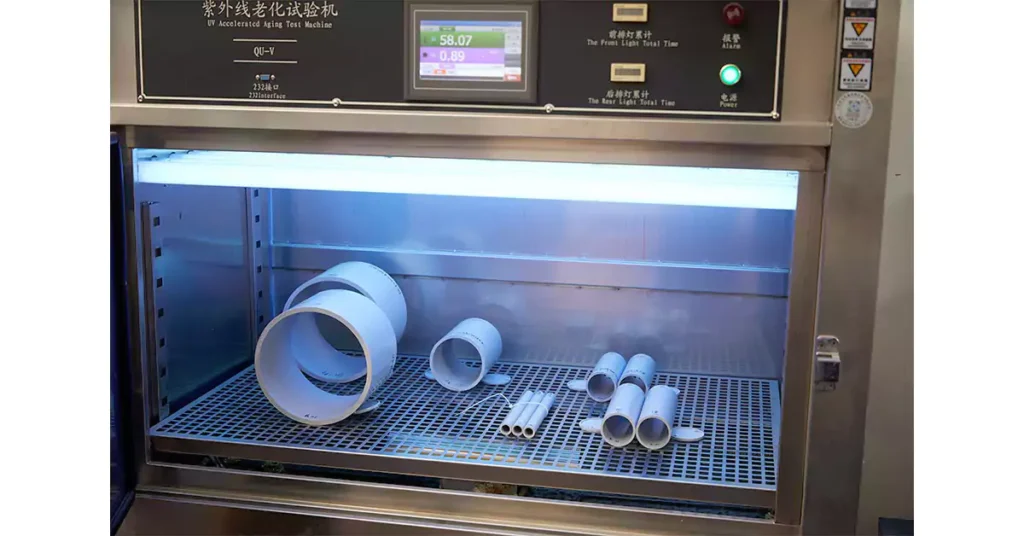
Heating Test
Thermal Conditioning:
Samples are placed in a heating cabinet for 4 hours ± 5 minutes at the declared temperature, with a tolerance of ±2 °C.
Temperatures are specified based on Table 2 of the standard, corresponding to the conduit’s classification.
Application of Load:
A mass, determined according to follow table, is applied to the sample using a steel rod of (6.0 ± 0.1) mm diameter.
The load is maintained for 24 hours ± 15 minutes, ensuring consistency in testing conditions.
Cooling Phase:
After loading, the sample is allowed to cool to room temperature while still under stress.
IEC 61386 Load for heating test
Classification to compression | Conductos | Mass Tolerance +1% |
1 | Muy claro | 0.5 |
2 | Luz | 1.0 |
3 | Medio | 2.0 |
4 | Pesado | 4.0 |
5 | Muy pesado | 8.0 |
Verification Test
After cooling, the sample is evaluated for deformation and functionality:
- The load is removed, and the sample is positioned vertically.
- A specified gauge is passed through the conduit under its own weight.
- The conduit passes the test if the gauge moves freely without additional force, demonstrating that the conduit has retained its shape and internal dimensions.
Resistencia al fuego
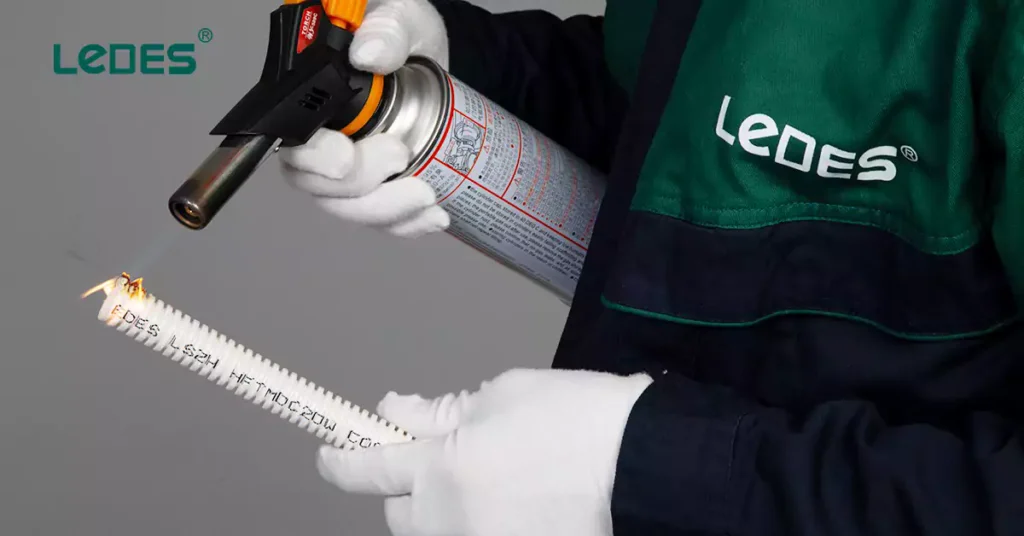
IEC 61386 includes specific requirements for assessing the fire resistance of conduit systems to ensure safety in electrical installations. The standard addresses the spread of fire and the ability of conduits to resist flame propagation and prevent fire hazards.
- Glow-Wire Test: Non-metallic and composite conduit fittings undergo a glow-wire test (IEC 60695-2-11) at 750 °C to check for ignition or sustained glowing. The fittings must not ignite, and any flames must extinguish within 30 seconds.
- Flame Test for Conduits: Non-metallic and composite conduits are tested using a 1 kW flame (IEC 60695-11-2). The sample must not catch fire or, if it does, must self-extinguish within 30 seconds, with no burning of the tissue paper underneath.
- Additional Fire Characteristics: In some regions, further testing is required for low acid gas emissions from conduits during combustion, such as IEC 60754-1 or AS/NZS 2053 standard for Australia.
The fire resistance tests ensure that conduits prevent the spread of fire and maintain performance during a fire, contributing to safer electrical systems in buildings and infrastructure.
External Influences of Conduits
IEC 61386 specifies requirements for the external influences that can affect conduit systems, focusing on protection against ingress of foreign materials, corrosion resistance, and overall durability under different conditions.
- Degree of Protection (Ingress of Foreign Objects): Conduit systems must have adequate resistance to external influences, with a minimum protection level of IP30. Testing is conducted to ensure that no dust or foreign objects ingress into the system, in accordance with IEC 60529 standards.
- Degree of Protection (Ingress of Water): Conduits must also resist water ingress. Systems are tested to ensure that water does not enter to the extent that it forms visible droplets. Testing is performed using the oscillating tube method, also under IEC 60529.
- Resistance to Corrosion: Metallic and composite conduits (excluding screw threads) must demonstrate adequate resistance to corrosion. Compliance is evaluated through tests specific to painted and zinc-coated steel or steel composite conduits. For non-ferrous metallic and composite systems, manufacturers must provide details on their corrosion protection methods.
- Corrosion Testing: For different levels of protection (low, medium, and high), conduits undergo tests involving immersion in solutions to assess resistance to rust and other forms of corrosion. These tests ensure that the materials retain their integrity and do not exhibit excessive corrosion.
The standard ensures that conduit systems remain functional and reliable in diverse environmental conditions, providing long-lasting protection against external hazards such as dust, water, and corrosion.
Electromagnetic Compatibility (EMC)
Objetivo: The purpose of electromagnetic compatibility (EMC) is to ensure that conduit systems do not interfere with, nor are they susceptible to, electromagnetic disturbances. EMC ensures that electrical and electronic equipment within conduit systems function properly without causing interference, or being affected by, external electromagnetic fields.
Importance:
Prevention of Electromagnetic Interference (EMI): Conduits that are part of an electrical installation must not emit harmful electromagnetic interference (EMI) that could affect nearby equipment, especially in sensitive environments like data centers or industrial control systems.
Protection from External Interference: Similarly, the conduit system should protect the wires inside from external sources of EMI that could cause malfunctions, signal distortion, or data loss. For example, in communications and high-speed data transmission systems, maintaining the integrity of signals is crucial.
Conduit Materials and Design: To meet EMC requirements, conduits may need to be designed using materials that have shielding properties or other characteristics that minimize EMI. This ensures that both the integrity of the electrical system and the safety of equipment are maintained.
Case Study for IEC 61386 Electrical Conduit
At Ledes, we are committed to producing high-quality, environmentally responsible conduit systems. Our LSZH (Low Smoke Zero Halogen) rigid and corrugated flexible conduits stand as a testament to our dedication to meeting the rigorous demands of global standards, ensuring performance, safety, and environmental sustainability.
Ledes' LSZH Rigid and Corrugated Conduit
LSZH Rigid Conduit: Ledes Conductos LSZH are available in medium duty and heavy duty types. The conduits are UV resistant, and can withstand extreme temperatures form -45℃ to 150 ℃, tested to pass V0 and 5VA rating of flammability. These conduits are ideal for installations requiring robust mechanical protection combined with fire safety. It is highly resistant to crushing, impact, and external influences, ensuring durability in demanding environments.
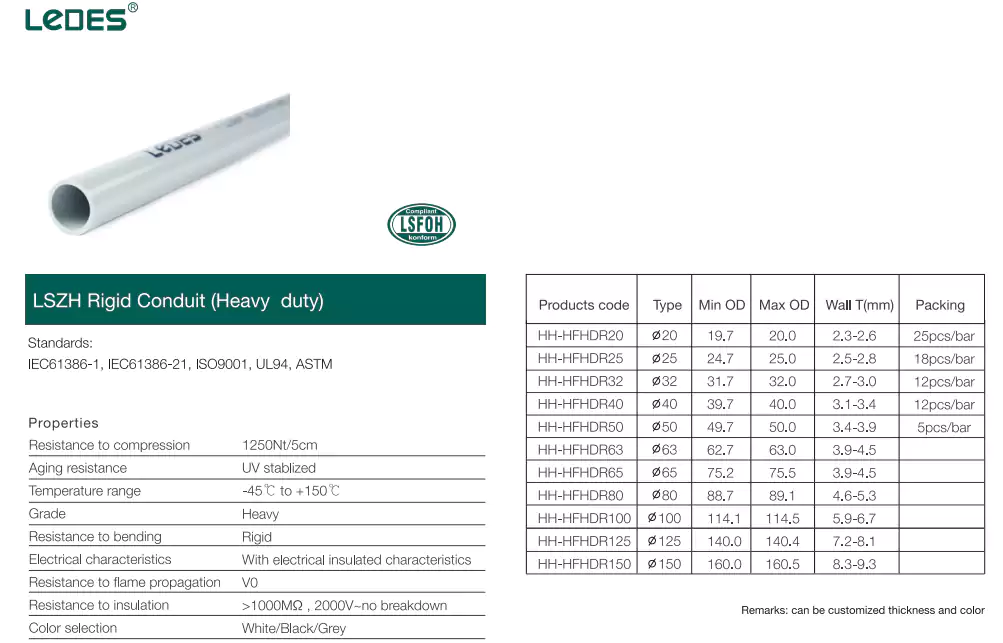
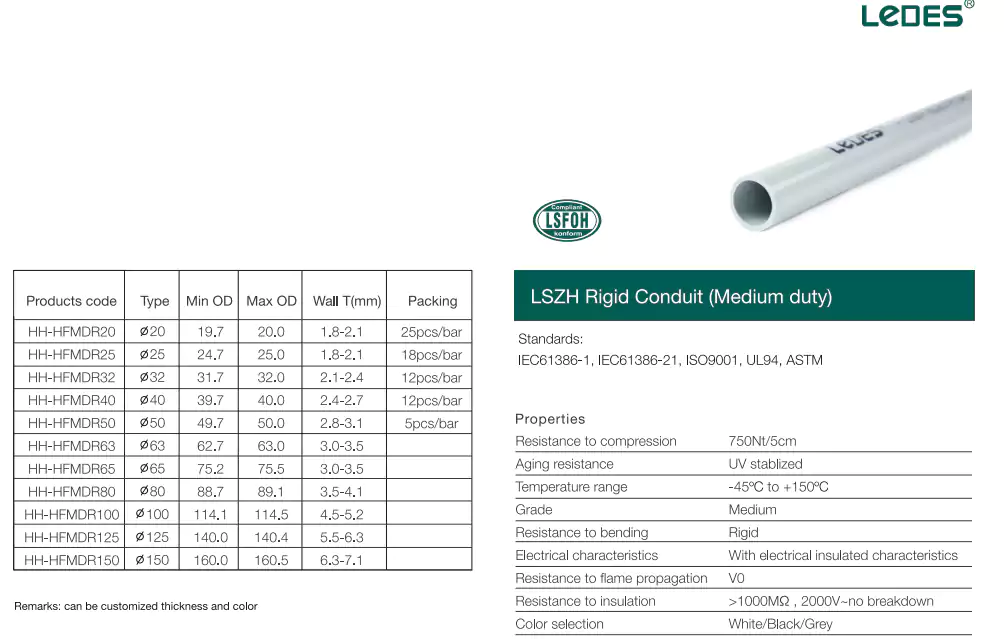
LSZH Corrugated Conduit: Heavy duty and medium duty for different application needs. Lightweight and flexible, this conduit is perfect for applications requiring ease of installation in confined spaces. Despite its flexibility, it retains excellent fire-resistance properties and mechanical strength.
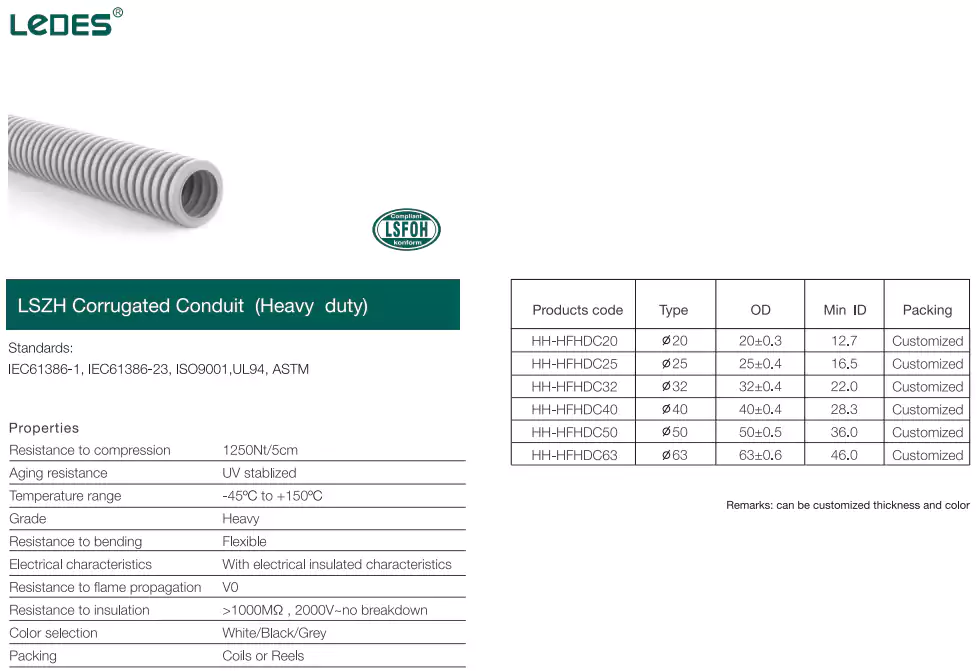
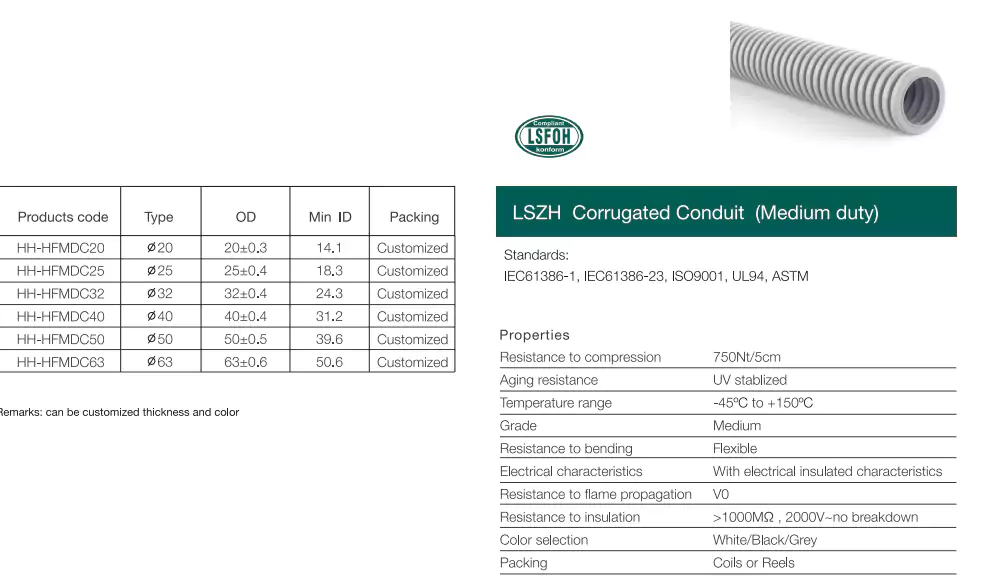
Both types of conduits are manufactured to meet stringent fire safety, low smoke, and halogen-free requirements, providing superior protection for both people and equipment.
Quality Control: From Raw Materials to Final Product
Ledes’ commitment to quality begins with raw materials and extends through every stage of production to final testing. Below is an overview of how Ledes ensures its LSZH conduits consistently exceed customer expectations.
- Raw Material Selection
Ledes uses premium-grade, halogen-free thermoplastics specifically formulated to produce low smoke and non-toxic emissions during combustion. All raw materials are subjected to rigorous quality checks to ensure compliance with key standards:
IEC 60754-1: Test on gases evolved during combustion of materials from cables – Determination of halogen acid gas content. This standard ensures that the material does not emit harmful halogen gases when exposed to fire.
BS EN 50267-2-2: Tests for halogen content of insulating materials. Compliance guarantees minimal halogen content in the raw materials.
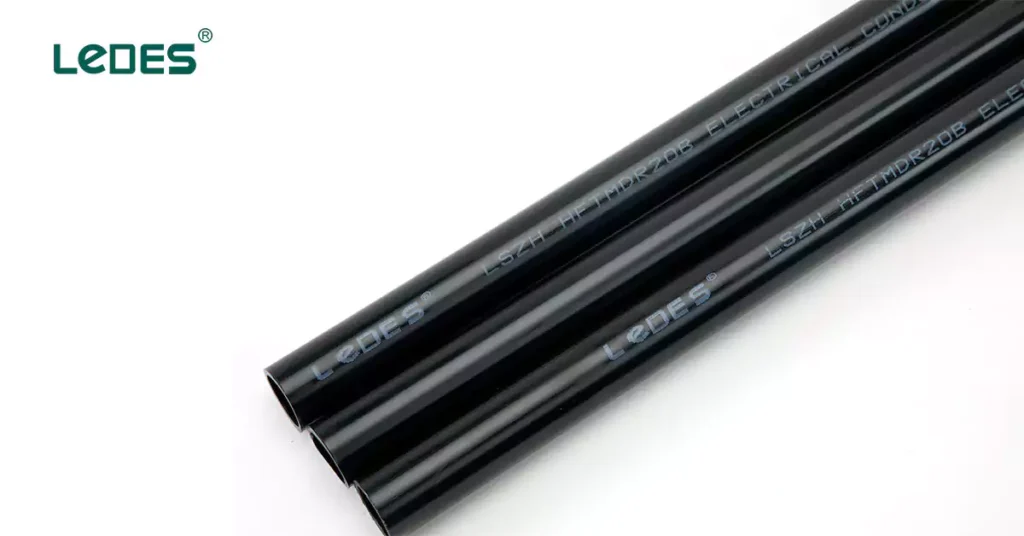
- Precision Manufacturing Process
Ledes’ LSZH (Low Smoke Zero Halogen) rigid and corrugated conduits are the result of a meticulously controlled manufacturing process designed to ensure consistent quality, reliability, and compliance with international safety standards. Here’s an in-depth look at how Ledes maintains its high standards from raw material selection to the final product.
- Extrusion Process: The Foundation of Precision
The production of Ledes’ LSZH conduits begins with the extrusion process, where raw materials are melted and shaped into conduit profiles:
Material Mixing: Halogen-free compounds, enhanced with UV stabilizers, flame retardants, and plasticizers, are accurately mixed using automated systems to ensure uniformity and consistency.
Temperature Control: The extrusion equipment maintains precise temperature settings, ensuring smooth material flow and preventing degradation of halogen-free compounds.
Dimensional Precision: Laser monitoring systems measure conduit thickness and diameter in real time during extrusion, guaranteeing that the products meet the strict specifications outlined in IEC 61386-1, IEC 61386-21, IEC 61386-23 and IEC 61386-24.
- Cooling and Solidification
After extrusion, the conduits are cooled using water baths or air chambers:
Controlled Cooling: Cooling rates are carefully regulated to prevent warping and maintain the structural integrity of the conduits.
Dimensional Inspection: Inline measurement tools verify the external dimensions, ovality, and wall thickness during this stage.
- Surface Finishing and Cutting
Post-cooling, the conduits are surface-finished and cut to size:
Accurate Cutting: Automated cutting machines ensure precise lengths for easy installation and compliance with project specifications.
Smooth Surface Finishing: The conduits are treated to ensure smoothness, reducing friction during cable pulling and enhancing installation ease.
- Final Quality Control Testing
Each batch of LSZH conduit undergoes rigorous quality control tests to verify performance against stringent standards:
UV Resistance Treatment: A specialized UV resistance test ensures that the conduits are capable of withstanding prolonged exposure to sunlight, making them ideal for outdoor installations.
Mechanical Tests: Compression and impact resistance tests, as required by IEC 61386-21 and IEC 61386-23, ensure the conduits can withstand physical stresses without deformation or failure.
Flammability Tests: Conduits are subjected to flame-retardant evaluations underUL94 for flame rating test, ASTM E662 and IEC 60754-1 for limiting oxygen index and smoke density, ensuring superior fire safety.
High and Low Temperatures: Temperature cycling tests (-45°C to 150°C) confirm the conduits’ resilience in extreme environments.
Chemical Resistance Tests: Conduits are exposed to chemicals and moisture to verify long-term resistance, meeting the requirements of BS EN 50267-2-3.
Ingress Protection Testing: Compliance with IEC 60529 standards ensures that the conduits are resistant to dust and water ingress.
Commitment to Excellence
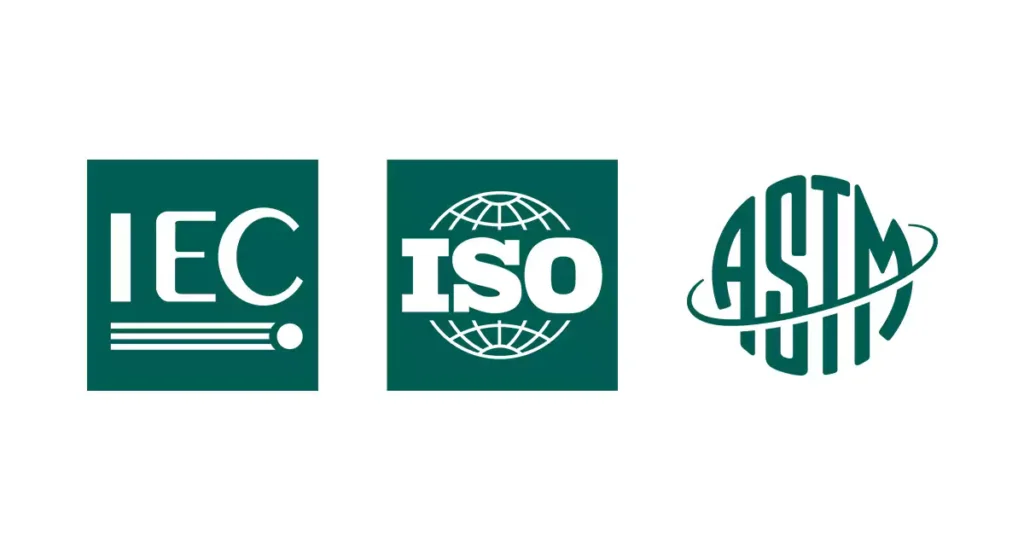
Ledes’ manufacturing process integrates stringent quality controls at every stage, from extrusion to final inspection. The company’s commitment to meeting and exceeding standards such as:
ASTM E662: Standard Test Method for Specific Optical Density of Smoke Generated by Solid Materials. This standard evaluates the amount of smoke a material produces during combustion, crucial for ensuring low smoke emission for LSZH conduits in fire scenarios.
IEC 60754-1: Test on Gases Evolved During Combustion of Materials from Cables – Determination of the Amount of Halogen Acid Gas. Assesses halogen acid gas emissions to confirm zero-halogen content, critical for LSZH certifications.
IEC 61034-2: Measurement of Smoke Density of Cables Burning Under Defined Conditions – Part 2: Test Procedure and Requirements. Establishes smoke density standards during fire, ensuring LSZH conduits meet visibility and safety needs.
IEC 61386-1: Conduit Systems for Cable Management – Part 1: General Requirements. Lays down general requirements for conduit systems, including dimensions, mechanical properties, and installation guidelines.
IEC 61386-21: Conduit Systems for Cable Management – Part 21: Particular Requirements for Rigid Conduit Systems. Focuses specifically on rigid conduits, covering mechanical and environmental performance criteria.
IEC 61386-23: Conduit Systems for Cable Management – Part 23: Particular Requirements for Flexible Conduit Systems. This standard specifies the particular requirements for flexible conduit systems, focusing on their mechanical and environmental performance.
IEC 61386-24: Conduit Systems for Cable Management – Part 24: Particular Requirements for Conduit Systems Buried Underground. Details requirements for conduits intended for underground use, emphasizing mechanical strength and environmental resistance.
ISO 4589-2: Plastics – Determination of Burning Behaviour by Oxygen Index – Part 2: Ambient-Temperature Test. Measures the limiting oxygen index (LOI) to determine flammability characteristics, verifying the fire-resistant properties of LSZH materials.
ISO TS 19700: Controlled Equivalence Ratio Method for the Determination of Hazardous Components of Fire Effluents. Provides a method for identifying hazardous substances in fire effluents, ensuring the overall safety of LSZH products.
These standards collectively ensure that LSZH conduits meet stringent safety, performance, and environmental criteria, offering reliability and safety for critical applications.
In conclusion, Ledes’ LSZH rigid and corrugated conduits are more than just products—they are a testament to innovation and meticulous engineering, designed to meet the needs of modern installations while prioritizing safety and sustainability.
6 Applications of IEC 61386-Certified Electrical Conduits
IEC 61386-certified conduits play a vital role in diverse industries, providing reliable, safe, and durable solutions for cable management and protection. These conduits, designed to meet the stringent requirements of the standard, cater to a wide range of environments and applications.
1. Renewable Energy Sector
Solar and Wind Installations: IEC 61386-certified conduits, such as rigid PVC and flexible corrugated options, ensure durable and UV-resistant solutions for cable protection in solar farms and wind turbines.
Energy Storage Systems: Conduits protect power and control cables in energy storage systems, maintaining safety in extreme temperature and environmental conditions.
2. Data Centers and IT Infrastructure
Gestión de cables: IEC 61386-certified conduits, particularly those with high flame resistance, safeguard data and power cables in server rooms and IT facilities.
Infrastructure Scalability: These conduits allow for easy upgrades and re-routing of cables in expanding digital infrastructure setups.
3. Transportation and Automotive
Railway Systems: Certified conduits protect wiring in railway tunnels, platforms, and signaling systems, offering resistance to mechanical impact and fire hazards.
EV Charging Stations: Conduits compliant with IEC 61386 provide robust solutions for electrical wiring in EV charging networks, addressing both underground and exposed installations.
Vehicle Wiring: Rigid and flexible conduits ensure safe cable routing in automotive manufacturing, withstanding vibrations and harsh conditions.
4. Construction and Infrastructure
Commercial and Residential Buildings: IEC 61386-certified conduits are used for concealed and surface wiring in high-rise buildings, ensuring safety and compliance with local electrical codes.
Smart City Initiatives: These conduits enable safe and efficient wiring for smart lighting, traffic systems, and urban IoT devices.
5. Industrial Environments
Heavy Machinery Protection: Rigid and corrugated conduits protect control and power cables in manufacturing plants, providing resistance to chemicals, impact, and high temperatures.
Oil and Gas Industry: IEC-certified conduits ensure safe cabling in explosive and hazardous environments, meeting strict safety standards.
6. Healthcare Facilities
Medical Facilities: Certified conduits ensure safe cable management in hospitals, maintaining high hygiene standards and minimizing fire risks.
Specialized Equipment: Conduits protect wiring in advanced medical equipment, ensuring uninterrupted operations.
Applications Specific to LSZH Conduits
IEC 61386-certified LSZH conduits offer additional safety benefits due to their low smoke and halogen-free composition. This makes them ideal for environments where fire safety and air quality are paramount:
Espacios públicos: LSZH conduits are used in theaters, airports, and malls, minimizing toxic emissions during fire incidents.
Confined Spaces: In tunnels, submarines, and underground facilities, LSZH conduits ensure safety by producing minimal smoke and no halogenated compounds during combustion.
Eco-Conscious Projects: LSZH conduits contribute to sustainable construction by adhering to stringent environmental standards.
Conclusión
As infrastructure, renewable energy, and smart technologies continue to evolve, the demand for high-quality, reliable conduit systems is more significant than ever. IEC 61386 certification provides a benchmark for safety, durability, and adaptability, ensuring conduit systems meet global expectations for performance in diverse applications.
The comprehensive testing and certification process ensures that IEC 61386-certified conduits, including both rigid and flexible options, offer resistance to physical damage, fire hazards, and environmental factors like UV exposure and extreme temperatures. These conduits not only comply with essential fire resistance and electromagnetic compatibility standards but also contribute to the sustainability of installations, particularly with options like LSZH (Low Smoke Zero Halogen) conduits, which prioritize fire safety and air quality in critical environments.
By understanding the standards, manufacturing processes, and quality controls, you can make informed decisions to elevate your projects with solutions that truly stand the test of time.



